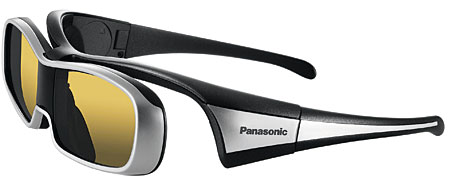Panasonic VIERA TC-P50VT25 Plasma 3D HDTV Page 3

The Panasonic ships with a single set of 3D glasses. Extra pairs are $150 each. I found them uncomfortable when I wore them on top of my critical video viewing glasses. It would help if the glasses’ hard plastic nose pads had real padding. I strongly recommend that you spend at least 15 minutes wearing any 3D set’s glasses to gauge your own personal comfort level before you write the check. Only the nose truly knows.
The relatively bright settings I used for the best 3D image on the Panasonic also suggest the use of caution to minimize the risk of plasma burn-in. There’s no need to be paranoid, but I’d avoid extended display of stationary images. I also suggest that you avoid a 3D marathon of 2.35:1 films (which involve black bars filling part of the screen) unless you turn down both the Contrast and Panel brightness controls—or switch to the dimmer Cinema mode.
And 2D?
The current catalog of Blu-ray 3D titles is too limited to fully test a set for the old standbys: video processing, color, resolution, and contrast. For those, we have to fall back on 2D sources—which in any case will comprise most of your HDTV viewing both now and for years to come.
The Panasonic performed reasonably well—though not perfectly—on our Video Test Bench regimen. It showed moiré on the HD transfer of Mission: Impossible III (the Vatican wall in chapter 7 and steps in chapter 8) when I played back the disc at 1080i. I also threw a number of real-world standard-definition discs at it and spent many hours watching SD programming over cable. While these sources triggered occasional artifacts (including some false contouring), none of them were particularly distracting.
One oddity will affect mainly collectors of early DVDs that weren’t mastered in 16:9. Examples of such discs are the first letterboxed release of Titanic and the Criterion Collection’s release of Armageddon. When you send the video to the Panasonic in either 480i or 480p, none of the set’s aspect ratio options will produce a properly proportioned image that fills the screen from left to right. To get around this, you have to upconvert the source to 720p, 1080i, or 1080p before it gets to the set. The upconversion can happen in the player, the set-top box (for letter- boxed films broadcast on some standard-definition channels), or the video processing in many recent A/V receivers.
As for color and resolution, in either 2D or 3D, I found nothing about the Panasonic to criticize (apart from the limited color calibration possible in 3D—as noted above). When I tested it side by side with my Pioneer KURO reference playing 2D sources, the color differences were essentially irrelevant. As for resolution, the Panasonic looked a hair crisper and more detailed. That’s likely due mainly to the screen size difference (50 inches versus 60 inches).
When it comes to black level and contrast, the Pioneer remains the champ—though by surprisingly little. When I measured it after about 150 hours of use, the Panasonic TC-P50VT25 produced the best black level we’ve yet seen or measured on a non-KURO plasma. At 0.004 foot-lamberts in 2D mode, it’s half the level we measured last month on Panasonic’s 2D TC-P50G20 (0.008 ft-L). On its 2D sets, Panasonic calls its current black level technology Infinite Black, and Infinite Black Pro for its 3D models. If our sample is representative, the Pro designation isn’t just added hyperbole.
Assessed side by side with the Pioneer KURO, on scenes averaging from just below mid-brightness to bright, the Panasonic appeared to have even more contrast than the Pioneer. The Pioneer clearly pulled ahead in the most difficult, dark material, due largely to its as yet unchallenged black level (for a plasma, remeasured at 0.001 ft-L after more than a year of near-daily use). Nevertheless, Panasonic is moving in the right direction. Apart from just a trace of grayness that’s visible in the darkest scenes and in a fully darkened room, I was very impressed by its overall black level and contrast.
Oddly, the Panasonic’s black level sometimes dropped into total blackness. This never happened in the midst of a film or TV program. Instead, it happened (occasionally) in transitions between a menu and the movie, between the trailers that sometimes precede a film, or in the broadcast breaks that lead into or out of commercials on cable. Since this total black wasn’t a factor on real-world source material, I consider the measured 0.004 ft-L to be the set’s lowest useful black level.
Conclusions
The Panasonic TC-P50VT25 breaks new ground in the reduction of motion lag and in black level for currently available plasmas. Even without its 3D features, it is an outstanding set. Whether you buy it for its 3D capabilities or consider them a bonus, they aren’t likely to disappoint if you love 3D in the theater and want to bring the experience home. Panasonic does plasma and 3D right.
- Log in or register to post comments












































